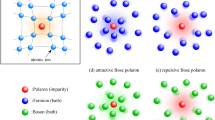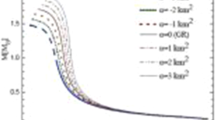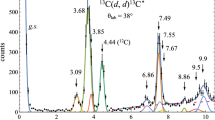Abstract.
Neutron stars with the isovector scalar δ-field are studied in the framework of the relativistic mean-field (RMF) approach in a pure-nucleon-plus-lepton scheme. The δ-field leads to a larger repulsion in dense neutron-rich matter and to a definite splitting of proton and neutron effective masses. Both features are influencing the stability conditions of the neutron stars. Two parametrizations for the effective nonlinear Lagrangian density are used to calculate the nuclear equation of state (EOS) and the neutron star properties, and compared to correlated Dirac-Brueckner results. We conclude that in order to reproduce reasonable nuclear structure and neutron star properties within a RMF approach, a density dependence of the coupling constants is required.
Similar content being viewed by others
References
S. Kubis, M. Kutschera, Phys. Lett. B 399, 191 (1997).
B. Liu, V. Greco, V. Baran, M. Colonna, M. Di Toro, Phys. Rev. C 65, 045201 (2002).
V. Greco, M. Colonna, M. Di Toro, F. Matera, Phys. Rev. C 67, 015203 (2003).
V. Greco, Phys. Lett. B 562, 215 (2003).
T. Gaitanos, Nucl. Phys. A 732, 24 (2004).
T. Gaitanos, M. Colonna, M. Di Toro, H.H. Wolter, Phys. Lett. B 595 , 209 (2004).
J.M. Lattimer, M. Prakash, Science 304, 536 (2004).
C. Maieron, M. Baldo, G.F. Burgio, H.J. Schultze, Phys. Rev. D 70, 043010 (2004).
R.C. Tolman, Phys. Rev. 55, 364 (1939)
J.R. Oppenheimer, G.M. Volkoff, Phys. Rev. 55, 374 (1939).
G.A. Lalazissis, J. König, P. Ring, Phys. Rev. C 55, 540 (1997).
R. Brockmann, R. Machleidt, Phys. Rev. C 42, 1965 (1990).
T. Gross-Boelting, C. Fuchs, A. Faessler, Nucl. Phys. A 648, 105 (1999).
B. ter Haar, R. Malfliet, Phys. Rep. 149, 207 (1987).
T. Gaitanos, C. Fuchs, H.H. Wolter, A. Faessler, Eur. Phys. J. A 12, 421 (2001).
A.B. Santra, U. Lombardo, Phys. Rev. C 62, 018202 (2001).
F. de Jong, H. Lenske, Phys. Rev. C 57, 3099 (1998).
P. Danielewicz, Nucl. Phys. A 673, 375 (2000).
P. Danielewicz, R. Lacey, W.G. Lynch, Science 298, 1592 (2002).
A.M.S. Santos, D.P. Menezes, Phys. Rev. C 69, 045803 (2004).
S. Typel, H.H. Wolter, Nucl. Phys. A 656, 331 (1999).
D.P. Menezes, C. Providencia, Phys. Rev. C 70, 058801 (2004).
Author information
Authors and Affiliations
Corresponding author
Additional information
A. Molinari
Rights and permissions
About this article
Cite this article
Liu, B., Guo, H., Di Toro, M. et al. Neutron stars with isovector scalar correlations. Eur. Phys. J. A 25, 293–298 (2005). https://doi.org/10.1140/epja/i2005-10095-1
Received:
Accepted:
Published:
Issue Date:
DOI: https://doi.org/10.1140/epja/i2005-10095-1




